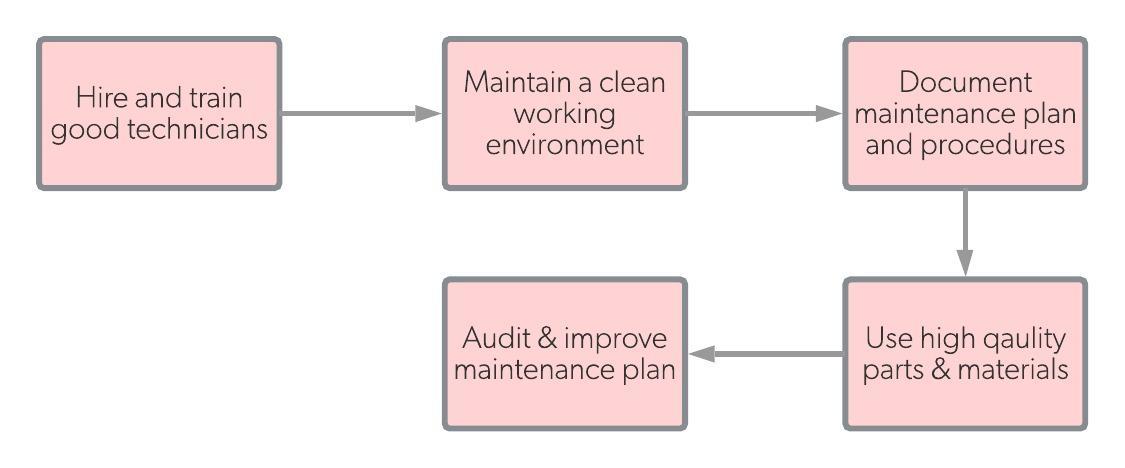What is precision maintenance?
While other maintenance types like preventive or predictive maintenance describe specific schedules or tasks, precision maintenance describes the maintenance culture in a facility. Specifically, a precision maintenance plan involves performing maintenance work in a consistent, precise, and industry-accepted way. If properly implemented, this means that the maintenance should yield the exact same results no matter who is performing the work.
Precision maintenance workflow

Overview
Precision maintenance requires a few specific factors to be successful, namely:
- Maintenance is controlled by knowledgeable, experienced employees
- Type of work is performed to industry standards (proven to work)
- All maintenance activities are rigorously documented to create an exact log of what was done and what improvements were implemented
For example, let’s say that a machine has a preventive maintenance task scheduled every week on Monday. On some Monday shifts (A), the machine works great and production runs smoothly. However, on other Monday shifts (B), the machine breaks down multiple times and slows production to a halt.
These problems result from different people performing maintenance without a consistent plan to follow. Because not every employee follows a precision maintenance plan, they perform maintenance work with wildly different outcomes, which ultimately impacts production.
Let’s take the same scenario and apply a precision maintenance plan. With this kind of plan in place, every maintenance technician performs the PM in the same exact way, with the same exact industry-standard tools, doing so in the most precise manner they can. They follow documented instructions and use the highest grade materials available.
Now, regardless of the maintenance technician on shift, the machine runs with no problems. In fact, because it is being maintained at its highest operating quality, production speed raises to a higher level.
Requirements of precision maintenance
In order for a precision maintenance plan to work, a facility needs to make sure the following things are in place:
- Educated, highly-trained employees
- Well-regimented preventive or predictive maintenance plan
- Simple, effective workflow for maintenance employees to follow
- Tested and documented maintenance procedures
- Regular improvements to process, design, and repair
How precision maintenance decreases downtime
Precision maintenance lowers downtime by making sure that each and every piece of equipment runs at its theoretical maximum efficiency. The goal here is to increase machine reliability, meaning that pieces of equipment breakdown far less frequently when they are maintained to high standards. In this way, reactive maintenance needs to be performed less often because the equipment is “up” for longer.
Take, for example, a vehicle. If the owner always waits until the last second to perform maintenance, uses low quality or questionable oil, and lets things break before fixing them, the vehicle runs at an equivalent level to this poor maintenance. However, if the owner performs precision maintenance by using high quality oil and fixes issues the moment they appear, the vehicle runs well. In theory, the well-maintained vehicle could last years longer than the poorly-maintained vehicle, saving the owner time and money..
Examples of precision maintenance
Because precision maintenance has a less specific definition, it can be applied across a wide range of industries and pieces of equipment. This means that it is up to the facility to decide what precision maintenance means for their equipment. What is “precise” for one machine might not be for another.
With this in mind, here are some general examples of precision maintenance in action:
- An operating environment that’s clean and free from contamination
- High quality lubricant materials
- Well-tuned machine vibrations
- Installed parts that meet strict specifications
- Tuned rotating parts that are true to center
An in-practice example is torque. If the nuts in a machine require a specific torque to lower vibration, the nuts should always be torqued to this exact specification. A precision maintenance plan would have these numbers documented so technicians never have to guess. Instead, they can reference the plan and torque to the precise number.
Benefits of precision maintenance
In addition to reducing downtime, precision maintenance plans:
- Create a positive maintenance culture
- Ensure the longest possible equipment lifespan
- Increase production via machine reliability
- Create a team of skilled and highly-trained employees
- Continuously improve process efficiency
Conclusion
When implemented properly, a precision maintenance plan can be a huge boon in regard to reducing downtime and increasing production levels. However, it requires careful planning, rigorous documentation, and skilled employees to perform maintenance work at its highest possible echelon.


![[Review Badge] GetApp CMMS 2022 (Dark)](https://www.datocms-assets.com/38028/1673900459-get-app-logo-dark.png?auto=compress&fm=webp&w=347)
![[Review Badge] Gartner Peer Insights (Dark)](https://www.datocms-assets.com/38028/1673900494-gartner-logo-dark.png?auto=compress&fm=webp&w=336)
